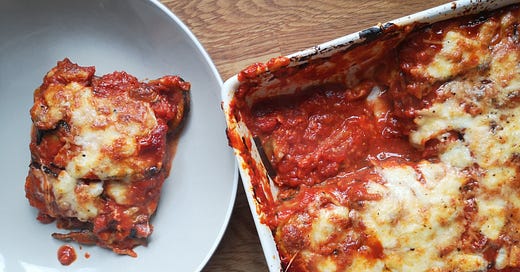Aubergine/Eggplant Week AKA What to Do with the Best Vegetable on Earth
From Georgian aubergine rolls to Aubergine Parmigiana
Welcome to The Sauce, deep travels through food and drink culture written by me, Charlie Brown, founder and former owner of what was once named Britain’s best independent wine store.
The Sauce is 100% reader-supported. For $5 a month or $50 a year, you’ll get access to hundreds of recipes and an ever-increasing number of food and wine commentaries and articles, as well as discounts on my remote wine consulting service.
I’ll teach you how to cook better. How to buy better drinks. How to cope with wine culture when it threatens to overwhelm you.
Your donation keeps the oven on and the pantry stocked. Thank you.
NB: Sorry friends over the pond, but I just can’t get on with calling aubergine eggplant hundreds of times over the next 2000-odd words. It’s going to be aubergine!
PRAISE THE LORD IT’S AUBERGINE SEASON!
These shiny-skinned, spongy fleshed vegetables are one of my favorites and they really come into their own during July.
Last week was been all about chicken so today we’re countering that with a whole host of vegetarian and vegan dishes made from the mighty aubergine.
Here’s your table of contents for today:
How to successfully roast aubergine without using ridiculous amounts of oil
Roasted aubergine recipes: marinated aubergines and Georgian aubergine rolls
The key to getting aubergine right
On their own, aubergines are freaking boring. They’ve got a weird texture. And if you stick them in a stew, putting them in raw and boiling them up without care and attention, they’re going to stay boring and weird and spongy even if that stew is full of punchy flavours.
They also need a LOT of salt. More than you think.
And yes, they do tend to soak up fearsome amounts of oil, although there are ways to mitigate this which we’ll get into.
The best way to get all the best flavor from aubergines is to broil, roast or BBQ them. These methods almost caramelize the flesh, making it sweeter and deeper in flavor than if you boil up raw chunks.
How to successfully roast aubergines without using a vat of oil
My go-to method for aubergine is always to roast them in the oven.
I’ve refined this method over many years after becoming obsessed with Greek fried aubergines but being terrified about how much oil they soaked up. This is a great alternative.
Pre-heat your oven to 180C/350F.
Slice your aubergine either lengthways or in rounds. You don’t want these too thin because aubergine shrinks a lot in the oven. Around 7-8mm (1/4-1/3 of an inch) thick is perfect.
Pour olive oil into a bowl. You’ll need around 3 tbsp for one aubergine but you may need more. Season the oil with salt.
Take a pastry brush and brush each piece of aubergine on both sides with the oil. No pastry brush? Use your fingers.
Place on a large baking tray in a single layer.
Put the aubergine into the oven. Turn every 6-7 minutes until they’re cooked through and have turned golden. This will take around 20-30 minutes. Aubergines have a habit of sticking. My hack is to do the first turn quite early on in the cooking process, around the 3-4 minute mark. I find once you turn, they won’t stick so get it turn early.
There are two incredibly easy recipes that you can make with roasted aubergine that I often make for a quick appetizer or snack. Marinated aubergines and Georgian aubergine rolls.
Marinated aubergines
This dish consists of roasted aubergines dressed in acid, oil and herbs or spices and left in the fridge to marinate for as long as you have. They can also be served warm.
My go-to dressing is equal parts lemon juice and olive oil whisked together with a handful of parsley, a smashed clove of garlic, and plenty of salt. Just make enough to cover the aubergines. A rough rule of thumb would be around 1.5 tbsp of lemon juice and the same of oil per aubergine.
Then you can riff. The following works particularly well:
Olive oil - sherry vinegar - parsley - oregano - garlic
Olive oil - lemon - ground cumin - oregano
Olive oil - garlic - lemon - cumin - pul biber chili flakes
Olive oil - pomegranate molasses - cilantro - garlic
Aubergines work brilliantly with Turkish, Middle Eastern and Southern Mediterranean flavours so think of those ingredients and experiment with what you have in your cupboards. How about Harissa? Za’atar? Sumac?
Georgian aubergine rolls
These are called nigvziani badrijani and in Georgia and you’ll find them everywhere. They use the classic Georgian flavours of cilantro and walnuts which are smashed into a paste, spread on cold strips of roasted aubergine, and rolled up.
Traditionally these rolls include a few things that are hard to find outside of Georgia like Tkemali (sour plum sauce) and blue fenugreek but you don’t need these to make this dish awesome.
2 aubergines cut lengthways into 1/3 inch strips and roasted as above
Walnuts and cilantro. A small handful of each chopped as finely as you can.
2 garlic cloves smooshed into a paste using a small amount of salt and the flat of a knife.
Optional — a pinch of fenugreek, ground into powder. A squeeze of lemon or pomegranate molasses.
Mix together the walnuts, cilantro and garlic. Add the lemon or pomegranate molasses if you’re using it. You don’t need much, just enough to make it like a paste.
Spread onto the roasted aubergine strips. Roll up. Serve.
Aubergine-friendly Capsule Pantry recipes
Albanian Fergesë (broil or roast and add to the mix)
Catalan Romesco Sauce (broil or roast and spoon the sauce on top)
Stewed Chicken with Aubergine, Chickpeas, Dates and Ras El Hanout
The big recipe — Aubergine Parmigiana
Serves 4
3 aubergines roasted in 1/4 inch rounds
600-800g / 21-28oz passata, chopped tomatoes or a mixture of both
3 garlic cloves finely chopped
Handful of basil finely chopped
1 ball of fresh mozzarella chopped into small cubes.
Grated parmesan
Pre-heat your oven to 180C/350F.
Roast your aubergines as above.
Meanwhile, make the tomato sauce. Heat a saucepan on low with a little olive oil. Add the chopped garlic and fry for a couple of minutes until fragrant but not golden.
Add the tomatoes and season well with salt and pepper. Turn down the heat and simmer the tomatoes with a lid for around 45 minutes or until you have a thick, concentrated sauce.
At the end of cooking, stir in the basil.
Take a baking dish something in the region of 10x7 inches.
Put a layer of tomato sauce on the bottom.
Place a single layer of aubergine on top.
Put another layer of tomato on top of the aubergine.
Sprinkle around half the mozzarella on the tomato and grate over a generous layer of parmesan.
Repeat with another layer of aubergine, tomato, and cheese.
Depending on your dish you’ll have either two or three layers of aubergine. You want to finish with a layer of cheese.
Place in the oven and cook until the cheese on top is melted and golden — around 30 minutes.
🍆 AND THAT’S ALL SHE WROTE. If you want more, check out the The Sauce archive.
🍆 IF YOU’RE NOT FOLLOWING ME ON SOCIAL MEDIA, that’s because I suck at it. But you can still follow me and see my sporadic Instagram posts here about life, wine, food, and general shenanigans here.
🍆 DO YOU WINE? If you do but struggle to know what to buy in your local area, I can help. SommAnywhere is my personalised wine recommendation service based on 10+ years in the wine trade. You fill out a quick quiz, I’ll tell you exactly what you should be buying and from where. Discounts for paid subscribers to The Sauce are available.
🍆 FINALLY, sharing The Sauce helps get the word out about what we’re doing here. If you’re picking up what I’m putting down, I’d love it if you would share The Sauce with friends and family. Just click the big blue button ⬇️








Roast eggplant slices with melted blue cheese or Gorgonzola. I know the blue is not widely appreciated but if you are feeling adventurous give it a try. Really delicious.
I'm drooling over that Parmigiana! My favorite tip with this veggie is to err on the side of over-cooking; under cooked aubergine is dreadful! Also many recipes call for slicing, salting, rinsing, and drying before seasoning and cooking, but in my experience that's only necessary with the big ponderous "eggplants" carried by most groceries here in the U.S. The longer, skinnier ones have thinner skins and generally don't need it, saving tons of time.